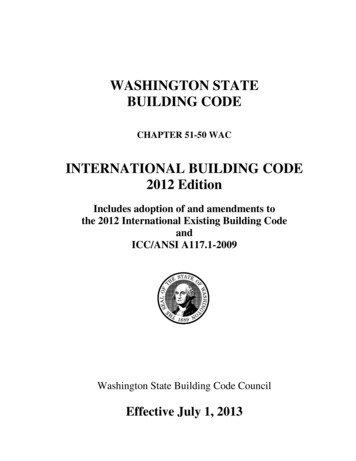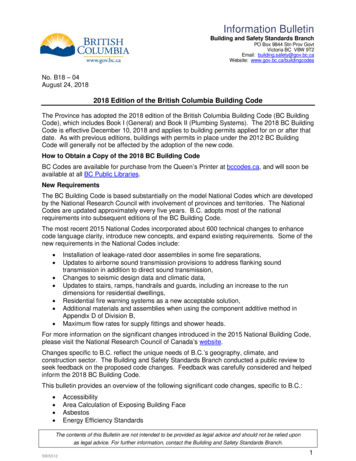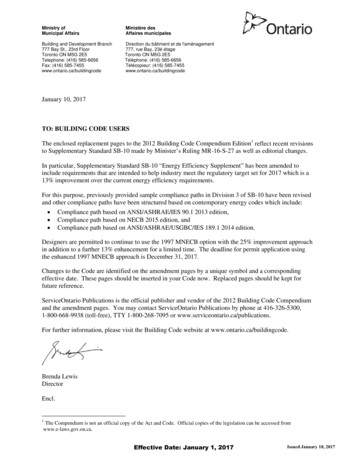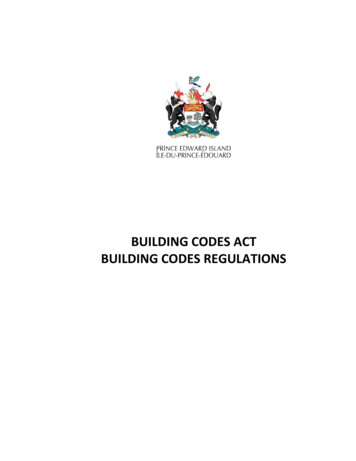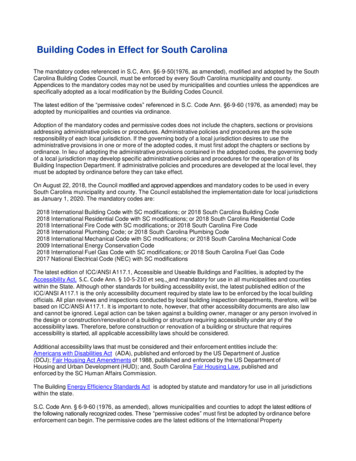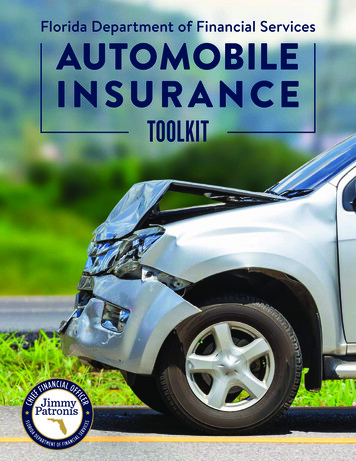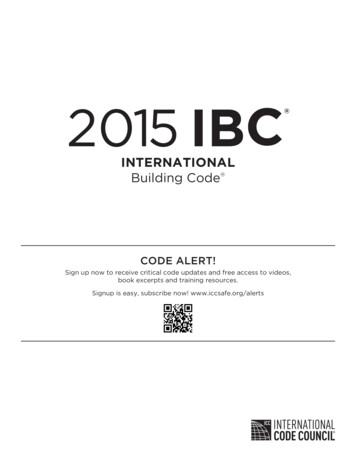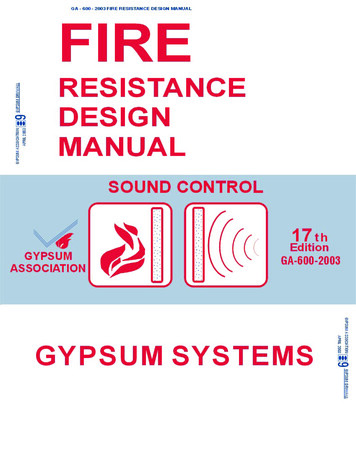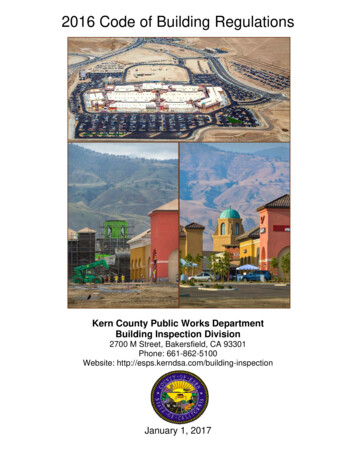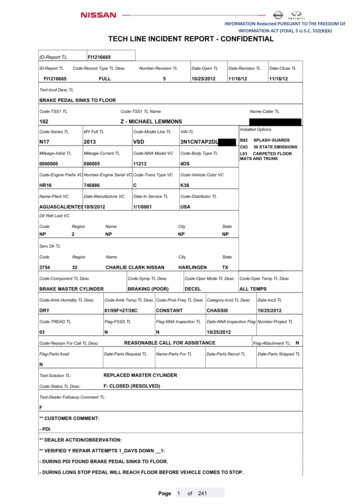
Transcription
Setting New Standards for SafetyTheFloridaBuildingCodeFlorida Building CommissionFlorida Department of Community Affairs
The Florida Building Code System The Florida Building Commission Florida Building Code Product Evaluation Approval Program Education Program Building Code Information System
Florida Building CommissionFormed from the Florida Board of Building Codesand Standards, plus five new positions.FBC has 23 members representing: Governor’s Chair Code Officials (4) Architect Structural Engineer Mechanical Engineer
Florida Building Commission Persons with Disabilities Public Education Municipalities/Charter Counties Fire Protection Engineer or Technologist Department of Insurance
Florida Building Commission Insurance Industry Building Management Industry Building Product Manufacturer Manufactured Buildings General Contractor
Florida Building Commission Residential Contractor Mechanical & HVAC Contractor Plumbing Contractor Electrical Contractor Roofing & Sheet Metal Contractor
Commission Powers & Responsibilities Adopt and update the FBC (every 3 years). Amend annually to incorporate interpretationsand clarifications Hear appeals of local boards of appealregarding interpretation of decisions oflocal building officials. Issue declaratory statementsinterpreting to the intent of theCode’s provisions.
Local Amendments Administrative Technical
Adjustments and Appeals Local building official makes first call Appeal to local adjustment and appeals board Appeal to Commission Appeal to judicial review through s. 120.68
www.floridabuilding.org Code Books & Materials Training Local Amendments ManufacturedBuildings and more!
Florida Building Code TrainingThe Commission is developing three levels of training: Transition training:a side-by-side comparison. Core course:covering administrativeand technical issues. Advanced technicalmodules will beginnext year andwill covereach licensedprofession.
Florida Building Code Training Required training on the Code:licensees regulated under Chapters468, 471, 481, 489, Florida Statutes,must complete a minimum of onecore course by June 1, 2003 orWithin two years of initialcertification or registrationWhichever is later.Note: Licensees regulatedunder FS 471 need onlyto complete the corecourse if they activelyparticipate in designingbuildingstructures or facilities.
Florida Building Code ApplicabilityThe Florida Building Code applies to:“ the construction, erection, alteration, modification,repair, equipment, use and occupancy, location,maintenance, removal and demolitionof every public and private building,structure,” 101.4.2 FBC
Florida Building Code Base Codes 1997 Standard Building Code 1997 International Plumbing Code 1998 International Mechanical Code 1999 National Electric Code 1997 Florida Energy Code 1999 National Fire Alarm Code 1997 Florida Accessibility Code
Florida Building CodeIncorporation of South Florida’s Standards“High Velocity Hurricane Zone (Miami-Dade andBroward Counties)” consists of thestrong hurricane provisionsadopted by South Florida inresponse to Hurricane Andrew.
Florida Building CodeIntegration of Fire Prevention and Life Safety CodesThe Florida Building Code adopts by reference theFlorida Fire Prevention Code as adopted by the StateFire Marshal: NFPA 1 Fire Prevention Code NFPA 101 Life Safety Code
Chapter 16 - Structural Loads Regulate minimum design dead loads,live loads, and impact loads for buildingsand structures. Provide for minimum wind design loads.
Chapter 16 - Structural LoadsDesign Methods: Performance» ASCE 7-98.» 1606.2 Low-Rise 60’ simplified method/special provisions.(Enclosed buildings, roof slope 30 degree if moment frame,approximately symmetrical cross section, includes tabulatedMWFRS and C&C loads) Prescriptive Residential» SBCCI SSTD 10» AF&PA Wood Frame Construction manual» FC&PA Guide to Concrete MasonryResidential Construction in highwind areas» WPPC Guide to Wood Construction inhigh wind areas
Chapter 16 - Structural LoadsDesign Methods: Metal Flag Poles» Designs using NAAMM FP-1001 specification for designloads of metal flag poles. Tower and Steel Antenna» Designs using ANSI/TIA/EIA 222 specification for designloads of antenna support structures.
Hurricane Protection Based on The American Societyof Civil Engineers StandardASCE 7-98 Requires buildings to withstand wind forcesresulting from design wind speeds Except: Broward County - 140 Mphand Miami-Dade County - 146 Mph
Hurricane ProtectionRequires additionalprotection from wind-bornedebris in:1. “Wind-borne debris region” where design speedsare greater than 120 mph or greater than 110 mphif within 1 mile of the coast. Except the Floridapanhandle where the region lies within 1 mile ofthe coast.2. “High velocity hurricane zone” of Miami-Dadeand Broward counties.
Equivalent Wind Speeds3 Second Gust Mph8590100105 110 120125 130140 145 150Fastest Mile Mph70758085105 110120 125 13090100For use with standards that arebased on fastest mile designsuch as SSTD10-99, etc
The Code Provides Two OptionsWind Borne Debris RegionNon High Velocity Hurricane Zone1. Design and build as “enclosed” with glazed openings protected byshutters or impact resistant glass.Exterior glazing that receives positive pressure in the lower 60 feet of abuilding shall be assumed to be openings unless such glazing is impactresistant or protected with an impact resistant covering meeting therequirements of: SSTD 12 ASTM E 1886 and ASTM E 1996 or Miami-Dade PA 201, 202, and 2032. Design and build as “partially enclosed” making the building capable ofwithstanding resulting combined external and internal wind pressures ifglazed openings fail.
High Velocity Hurricane Zones(Miami-Dade andBroward Counties) Florida Building Code,Section 1619 Wind Load Minimum standard,Chapter 6 of ASCE 7-98 Minimum wind velocity (3 second gust)Broward - 140 mphMiami-Dade - 146 mph Exposure Category C asdefined in ASCE 7
Exposure Definitions Exposure B:“Urban and Suburban areas, wooded areas, or otheterrain with numerous closely spaced obstructionshaving the size of single-family dwellings or larger.”
Exposure Definitions Exposure C:“Except in the high velocity hurricane zone, the area which lieswithin 1500 feet of the coastal construction control line, or within1500 feet of the mean high tide line, whichever is less, exposurecategory C shall be applicable in the coastal building zone set forin the s. 161.55(5), Florida Statutes.” Coastal Construction Control Line (CCCL) isestablished by DEP. Mean high tide line is established by FEMA.The mean high tide line is seaward of the CCCL. Coastal Building Zone is the area starting fromthe “Seasonal high water line” up to 1,500 ft orthe whole barrier island if less than 5,000 ft.
Roof Assemblies & Rooftop Structures Section 1504.1 WindResistance of Roofs. Roof decks and roofcoverings must bedesigned to Chapter16.
Roof Assemblies & Rooftop Structures1507 Roof Coverings withSlopes 2:12 or greater. 1507.3 Asphalt Shingles1507.3.6 Fasteners» Requires the use of roofing nails1507.3.7 Attachment» In wind zones up to 110 mph,prescriptive provision of 4 fastenersper shingle. In wind zones greaterthan 110 mph, fastening is basedeither on ASTM D 3161 test(modified to 110 mph) or MDC PA107-95 tests.
Ch. 17: Structural Tests & Inspections Exterior Window and Glass Door Assemblies Design pressure for window and door assemblies shallbe calculated as per s. 1606. Testing - NSI/AAMA/NWWDA 101/IS2 2/97. Labeling - bear an AAMA or WDMA or other approvedlabel identifying the manufacturer, performancecharacteristics and approved product evaluation entity. Anchorage requirements for anchorage of window anddoor assemblies to the main wind force resisting system.
Existing Buildings Alternation, repair or rehabilitation work mustconform to the requirements of the technicalcode for new construction. The building official shall determine the extentto which the existing system shall be made toconform to the requirements of the technicalcode for new construction.
Repairs and AlterationsRepairs and alterations not increasing the area of the buildingmade within any 12 month period. Structural repairs and alterations, the cost of which 25 percent of thevalue of existing building or structures shall comply with the requirements ofthe new building code except that minor structural alterations, with theapproval of the building official may be made of the same materials. Non-structural repairs and alterations, the costof which 25 percent of the value of existingbuildings or structures and which do not affectegress or fire resistivity, may be made of thesame materials of which the building or structureis constructed.
Repairs and Alterations Repair and alterations 25 percent but not exceeding 50 percent of thevalue of the existing building may be made during any 12 month periodwithout making the entire existing building comply, provided such repairsand alterations comply with the requirements of this code for a building oflike area, height and occupancy. The replacement of garage doors, exterior doors, skylights, operative andinoperative windows shall be designed and constructed in accordance withChapter 16 of the new code. When repairs and alterations amounting tomore than 50 percent of the value of the existingbuilding are made during any 12 month period,the building or structure shall be made to conformto the requirements for a new building or structureor be entirely demolished.
Energy Efficiency Code for Building Const. Methods A & B Adopts the new Windowsbase FLA/COM into thecode.
How the Energy Code WorksThe code compares a residentialbuilding’s potential annual energy useas it will be built to that of a baseline buildingwith optimized features. Here is an example:WindowsWallsCeilingFloorHVACDuctsAir handlerHot waterE-RatioAs-BuiltNorth, Central: U-.5, .4 SHGCSouth: U-.5, .4 SHGC18% window/floor ratio, no OHR-11 frame wallR-30 flatNorth, Central: SOG R-3.5South: SOGSingle pane clear15% wfr, 2' OHR-3 CBSR-19 flatSOG R-0R-0Heat pump, 10 SEER/6.8 HSPFR-6 in the attic, leakyIn the garageEF .8810 SEER/6.8 HSPFR-6 attic, leaky?In the garageEF .88As Built/Baseline E-Ratio (1.0 or less Passes)
Requirements for Air Handlers in Attics Service panel of an air handler isno greater than 6' from an atticaccess.Attic access opening is adequatetoreplace the air handler.Device is installed to alert theowner or shut down the unit whenthe condensation drain is notworking properly.Notice should be posted to informthe owner that the air handler islocated in the attic.
VentilationThere are two means of ventilation:1. Ventilation by natural means by providing a minimumoperable opening to the outdoors of 4% of the floor.2. Ventilation by mechanical means.
Florida Product Approval System Product approval under the new Florida Building Codewill not only ensure that safe products and technologiesare used in building construction, but will encouragenew products and technologies that can increase safetyor meet safety requirements through less expensivemeans. The new system will include a web-site for submittal ofapplications, payment of fees for statewide productapprovals and entity approvals. In addition, a databasewill be made available to search a list of approvedentities and products approved for statewide use.
Florida Product Approval System Criteria has been established for approval through thestate of public and private entities that test, evaluateand certify products. Quality assurance programs willbe used to monitor product code compliance. This two pronged system will allow manufacturers thechoice of applying with local jurisdictions for localapprovals or to apply with the Florida BuildingCommission for statewide approval of products,materials, or methods of construction.
Florida Entity Approval SystemThe Florida Building Commission will approvepublic and private entities that test, evaluateand certify products.Accreditation Bodies Accreditation bodies accredit and monitor thecompetency and performance of an agencycarrying out specific tasks.Evaluation Entities Evaluation entities conduct product evaluationsbased on test reports, and/or rational analysis.Testing Labs Testing labs conduct product tests.
Florida Entity Approval SystemCertification Agencies Certification agencies evaluate products basedon tests and/or rational analysis; conduct qualityassurance; certify compliance with standards;and list and label products.Quality Assurance Agencies Quality Assurance agencies monitor productproduction.Validation Entities Validation entities certify compliance withstandards and certify that product approvalapplications are correct.
Local Product Approval SystemBefore and After Before October 1, 2003, local jurisdictions will continue to approve allproducts as they have in the past, including accepting productsapproved for use by Miami-Dade Product Control Division. Local jurisdictions may also adopt the Florida Product ApprovalSystem before October 1, 2003 for local implementation prior to thatdate. After October 1, 2003, local jurisdictions will approve all productsusing the procedures of the Florida Product Approval System.
Local Product Approval SystemProducts with PrescriptiveProvisions in the Code (Method 1) Approved by the building plan review and inspectionprocess
Local Product Approval SystemProducts with Code Performance Criteria andStandardized Testing, or Comparative or RationalAnalysis (Method 2)Products with Certification Mark or Listing (Option A) Product certification mark or listing from an approved certification agency. Code compliance certified to standards adopted by the Code.
Local Product Approval SystemProducts with Code Performance Criteria andStandardized Testing, or Comparative or RationalAnalysis (Method 2)Products with Test Reports (Option B) Product test report from an approved testing lab. Identifies which products are covered by the report. Verifiable documentation the product complies with the Code. Product is manufactured under an audited quality assurance program.
Local Product Approval SystemProducts with Code Performance Criteria andStandardized Testing, or Comparative or RationalAnalysis (Method 2)Products with Evaluation Report from An ApprovedEvaluation Entity (Option C) Product evaluation report from an approved evaluation entity. Based on testing or comparative or rational analysis (or a combination). Report indicates the product to be in compliance with the intent of the Codeand at least equivalent to that required by the Code. Product is manufactured under an audited quality assurance program.
Local Product Approval SystemProducts with Code Performance Criteria andStandardized Testing, or Comparative or RationalAnalysis (Method 2)Products with Evaluation Report fromFlorida Architect or Engineer (Option D) Signed and sealed product evaluation report from a Florida RegisteredArchitect or Florida Professional Engineer. Based on testing or comparative or rational analysis (or a combination). Report indicates the product to be in compliance with the intent of the Codeand at least equivalent to that required by the Code. Product is manufactured under an audited quality assurance program.
Local Product Approval SystemProducts for which there are no specificStandardized Testing, or Comparative orRational Analysis Methods (Method 3)Products with Evaluation Report fromAn Approved Evaluation Entity (Option A) Product evaluation report from an approved evaluation entity. Based on testing or comparative or rational analysis (or a combination). Report indicates the product to be in compliance with the intent of the Codeand at least equivalent to that required by the Code. Product is manufactured under an audited quality assurance program.
Local Product Approval SystemProducts with Code Performance Criteria andStandardized Testing, or Comparative or RationalAnalysis (Method 3)Products with Evaluation Report fromFlorida Architect or Engineer (Option B) Signed and sealed product evaluation report from a Florida RegisteredArchitect or Florida Professional Engineer. Based on testing or comparative or rational analysis (or a combination). Report indicates the product to be in compliance with the intent of the Codeand at least equivalent to that required by the Code. Product is manufactured under an audited quality assurance program.
State Product Approval SystemProducts with Code Performance Criteria andStandardized Test, or Comparative or RationalAnalysis (Method 1)Product Certification Mark or Listing (Option A) Product certification mark or listing from anapproved certification agency. Code compliance certified to standards adoptedby the Code.
State Product Approval SystemProducts with Code Performance Criteria andStandardized Test, or Comparative or RationalAnalysis (Method 1)Products with Test Reports (Option B) Product test report from an approved testing lab. Identifies which products are covered by the report. Verifiable documentation the product complies withthe Code. Product is manufactured under an audited qualityassurance program.
State Product Approval SystemProducts with Code Performance Criteria andStandardized Test, or Comparative or RationalAnalysis (Method 1)Product with Evaluation Report fromAn Approved Evaluation Entity (Option C) Product evaluation report from an approved evaluation entity. Based on testing or comparative or rational analysis(or a combination). Report indicates the product to be in compliancewith the intent of the Code and at least equivalent tothat required by the Code. Product is manufactured under an audited qualityassurance program.
State Product Approval SystemProducts with Code Performance Criteria andStandardized Tests, or Comparative or RationalAnalysis (Method 1)Products with Evaluation Report fromFlorida Architect or Engineer (Option D) Signed and sealed product evaluation report from aFlorida Registered Architect or Florida ProfessionalEngineer. Based on testing or comparative or rational analysis(or a combination). Report indicates the product to be in compliance withthe intent of the Code and at least equivalent to thatrequired by the Code. Product is manufactured under an audited qualityassurance program.
State Product Approval SystemProducts Which Have No Standardized Tests,or Comparative or Rational Analysis (Method 2)Evaluation Report from Evaluation Entity (Option A) Product evaluation report from an approved productevaluation entity. Provides verifiable documentation that the productcomplies with the Code. The product is manufactured under an audited qualityassurance program.
State Product Approval SystemProducts Which Have No Standardized Tests,or Comparative or Rational Analysis (Method 2)Evaluation Report from Florida Architect or Engineer(Option B) Signed and sealed product evaluation report from aFlorida Registered Architect or Florida ProfessionalEngineer. Based on testing or comparative or rational analysis(or a combination). Provides verifiable documentation that the productcomplies with the Code. Product is manufactured under an audited qualityassurance program.
Florida Building Code Change Cycle Update to new edition of model codes every 3 years. Annually amend to integrate interpretations andupdate editions of reference standards.
Building Code Amendment Process Amendments proposed by a deadline date. Proposed amendments posted on internet for 45 days. Technical advisory committees vote on recommendedaction. Proposed amendments and recommended actionposted on internet for 45 days.
Building Code Amendment Process Commission takes action on proposed amendmentsand conducts Chapter 120, F.S., Notice of Change. Commission finalizes rule change. Changes effective after 3 months for annualamendment and after 6 months for 3 year majorupdates.
www.floridabuilding.orgVisit the FloridaBuilding CodeInformationSystem today!
protection from wind-borne debris in: 1. “Wind-borne debris region” where design speeds are greater than 120 mph or greater than 110 mph if within 1 mile of the coast. Except the Florida panhandle where the region lies within 1 mile of the coast. 2. “High vel

